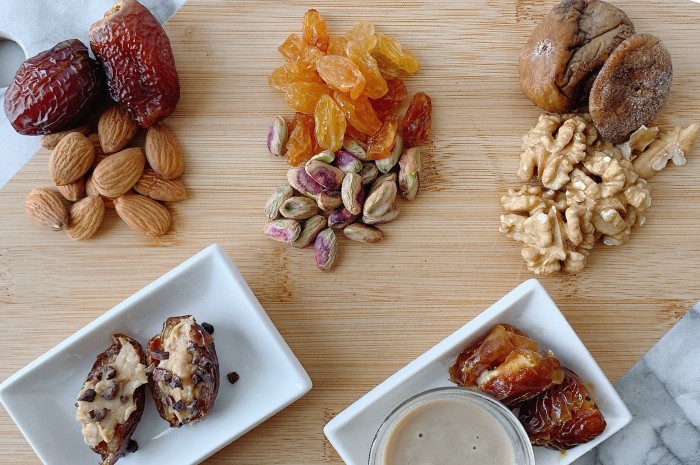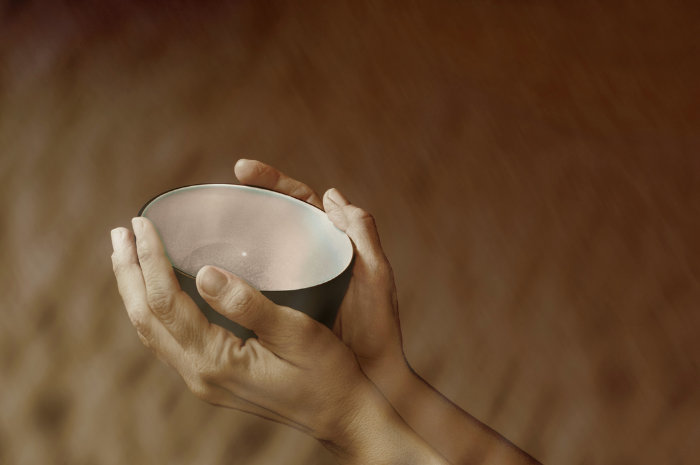Download your FREE ebook!
What to Eat on a No-Sugar Meal Plan

Anyone considering going on a no-sugar challenge or diet plan wants to know first and foremost, what can I eat?
I describe my method for an easy and sweet no-sugar challenge here where I explain the three stages of reducing your sugar cravings.
I’ve done no-sugar challenges where there was no sweetness at all, except berries, which are known for being the lowest sugar fruits. I was miserable! I would overindulge on nuts and nut butter and cheese! I need sweetness in my life and a strict challenge like that does more harm than good for someone like me that has no intention of quitting all sweet foods forever. I believe that craving sweet foods is natural, the same way we would crave bitter, sour or salty. So as I explained in the previous post, the aim is to reduce our sweet tooth and be able to enjoy naturally sweet foods in moderation.
The stages, therefore, go from relatively strict to less strict, with certain foods not allowed in all stages, and certain foods introduced after each stage, as highlighted in the chart below. Aim to stick to each stage for a minimum of 5 days.

What to Eat in Stage 1
The only sweet foods allowed in this stage will be fresh or frozen fruits. No fruit juice is allowed, except lemon. And I would avoid juicing vegetables such as beetroot and carrot and combining them as those can be quite sweet also.

As mentioned in the 7 Easy Tips to Stop Sugar Cravings post, it’s best to include fat and protein in every meal or snack to help curb your sugar cravings, while also including fruits and sweet vegetables. Here are some examples:
- Seasonal Fruit – check what’s in season and go for it as it will be at it’s sweetest. When I did the no-sugar challenge in October I was able to enjoy the juiciest fresh figs.
- Vanilla Cashew Butter – I add cinnamon and lacuma powder as in this recipe also, and just have a spoonful on its own with a tea or hot chocolate in the morning. Also amazing on a baked sweet potato or toast with some sliced banana for extra sweetness.
- Pumpkin Chickpea Quinoa Salad – this is the perfect example of a meal that has protein, fiber and healthy fats. The pumpkin and pomegranate add a lovely sweetness to the dish that you can enjoy in all the stages of the no sugar challenge.
- Caramelized Onions – caramelizing onions brings out their natural sweetness that is delicious and very versatile. Add them to avocado toast, with scrambled eggs or tofu, on top of pizza with goat cheese, or roasted veggies (see below). All you need to do is warm a frying pan with a little olive oil or butter on medium heat, then add sliced onion (add more than you think as it will reduce considerably) with a pinch of salt, and then stir occasionally until the onions are dark brown. This can take between 20-30 minutes.
- Roasted Root Vegetables – as with the onions, roasting vegetables brings out their natural sweetness. Chop some sweet potato, pumpkin, butternut squash, carrots and beetroot into similar sized chunks. Toss in some olive oil with salt, pepper and sweet spices such as cinnamon and sweet paprika. Bake until cooked through with the edges nicely caramelized. Enjoy as a side dish drizzled with some tahini, or serve as a main dish with some quinoa and pesto. Leftover vegetables can be turned into a soup by adding into a blender with some vegetable stock.
- Sweet Potato – the sweetest of vegetables! Make sweet potato ‘toast’ by slicing the sweet potato into thin planks and then roasting with a little oil, salt and pepper. It’s delicious on its own with a sprinkle of cinnamon, and even better with a drizzle of almond butter and sliced banana. Perfect for breakfast in stage 1.
- Banana Nice Cream – you can enjoy it plain or make it with some cacao powder by following this recipe. Just make sure to leave out the maple syrup and chocolate sauce if you’re in stage 1.
- Smoothies – a good place to start is with a frozen banana, spinach (believe me you won’t be able to taste it) and a liquid of choice such as coconut water or almond milk. Then add in your choice of healthy fats and protein. Good options for both would be any nut or seed butters. Avocado is a great healthy fat that can add a lovely creaminess to your smoothie. Ground flax seeds, chia seeds, and hemp seeds are also great options. Check out this beginner’s green smoothie recipe.
- Kale chips – I know these are not sweet…but those times when you usually have a sweet snack, a satisfying snack with the important components of fiber, protein and healthy fats will help curb your sugar cravings.
- Chestnuts – with a slight sweet taste and starchy satisfaction, roasted chestnuts is a great option for when you would normally grab a sweet snack, and especially if they are in season.
What to Eat in Stage 2

In this stage, you can introduce dried fruit in moderation. You have been working hard on taming your sweet tooth, so we don’t want to undo all that effort with an excess amount of dried fruit, especially our BFF, dates! Furthermore, to keep your blood sugar levels in check, and stay full for longer after any meal or snack, make sure you include healthy fats and protein with the dried fruit. It also helps to keep them less sweet. Here are some ideas to get you started:
- Energy balls – an easy snack to make and adaptable to the ingredients you have available. You can use dates or other dried fruits, or a mix of dried fruit, with nuts, seeds, coconut and oats with some flavoring additions of choice. You get your fiber, fats, and protein in a portable snack. Another option is to make these superfood stuffed dates.
- Trail mix – combine your favorite raw nuts, seeds and dried fruit for a lovely snack to enjoy with some herbal tea in the afternoon.
- Pancakes – adding banana and dates to your pancake batter gives them a lovely sweetness without needing to add any syrup. Serve with some fresh berries.
- Hot chocolate – blend a couple of small dates in a cup of dairy-free milk, then strain the milk, and proceed to make a delicious hot chocolate to enjoy any time of day.
- Arabic Coffee Frappe – using dates or date paste to sweeten your latte will make you forget all about your usual Starbucks fix. By adding tahini you are getting a good dose of healthy fats, and using Arabic coffee stead of the usual espresso works perfectly with the flavor of tahini.
What to Eat in Stage 3

In stage 3 we can start including a limited amount of natural sweeteners such as honey, maple syrup or coconut sugar. According to the World Health Organization, the recommended daily consumption of added sugars should not exceed 25g for an average adult. This does not include sugar in fruits and vegetables but does include fruit juice since it’s missing the fiber from the whole fruit.
So far you’ve been practicing having zero added sugar in stages 1 and 2. This is great because soon you will realize that 25g of added sugar is not a lot. See below to get an idea of what that may look like in a day:
An average day with 25-30g of added (natural) sugar would look like this:
1 teaspoon coconut sugar in your morning coffee = 4g
1 teaspoon honey on your oatmeal = 6g
1 tablespoon of Ketchup with some fries at lunch = 3.7g
1 teaspoon maple syrup in your salad dressing for dinner = 5g
1 serving (30g) of 70% dark chocolate for dessert = 9g
Keep in mind foods that might have sugar such as bread, pasta sauce, and dairy-free milk. Make sure they are included in your count for the day.
For more recipe ideas using natural sweeteners download my guilt-free desserts e-book. And make sure to read my top tips to get you through the challenge. And if you haven’t already check out the No Sugar Challenge playlist on YouTube.




Leave A Comment